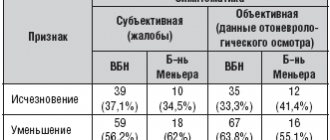Venlafaxine
Venlafaxine does not have increased binding to plasma proteins, and practically does not increase the concentration of concomitantly used drugs, which are characterized by high binding to plasma proteins. No clinically significant interaction with antihypertensive (of many pharmacological groups, including beta-blockers, angiotensin-converting enzyme inhibitors and diuretics) and hypoglycemic agents has been identified. Caution should be exercised when used concomitantly with other drugs that affect the central nervous system, since combinations of venlafaxine with such drugs have not been studied.
MAO inhibitors
The simultaneous use of venlafaxine with MAO inhibitors, as well as within 14 days after their discontinuation, is contraindicated (the risk of severe side effects, including death, is likely). Therapy with MAO inhibitors can be carried out no less than 7 days after discontinuation of the drug Venlafaxine. Venlafaxine should be discontinued at least 7 days before starting the use of reversible selective MAO inhibitors (moclobemide). The weakly reversible and non-selective MAO inhibitor linezolid (an antimicrobial agent) and methylene blue (intravenous dosage form) are also not recommended for concomitant use with venlafaxine.
Serotonergic agents
Caution should be exercised in the simultaneous use of drugs that affect the serotonin system of mediators, such as triptans (sumatriptan, zolmitriptan and others), selective serotonin reuptake inhibitors (SSRIs) and SNRIs (prolonged convulsions have been reported), tricyclic antidepressants, lithium, sibutramine or fentanyl (and its analogs dextromethorphan, tramadol and others), as well as excess sources of tryptophan due to the increased potential risk of serotonin syndrome.
Ethanol
During treatment with venlafaxine, ethanol (alcohol) should be completely avoided. Ethanol increases the psychomotor dysfunction that venlafaxine can cause.
Lithium
Lithium preparations do not have a significant effect on the pharmacokinetics of venlafaxine.
Diazepam
There was no effect of diazepam taken orally on the pharmacokinetics of venlafaxine and EDV and, conversely, venlafaxine did not change the pharmacokinetics of diazepam and its metabolite desmethyldiazepam. In addition, the use of both of these drugs does not impair the psychomotor and psychometric effects caused by diazepam.
Cimetidine
The simultaneous use of cimetidine and venlafaxine resulted in a delay in metabolism during the “primary passage” of venlafaxine through the liver. The clearance of venlafaxine when taken orally decreased by 43%, and the AUC (area under the concentration-time pharmacokinetic curve) and maximum concentration (Cmax) in the blood plasma of this drug increased by 60%. However, similar effects were not evident for EFA. Since the total activity of venlafaxine and EDV is expected to increase only slightly, no dose adjustment will be required for most normal patients. However, for patients with existing (identified) arterial hypertension, elderly patients and those with impaired liver or kidney function, a dose adjustment of venlafaxine is possible.
Haloperidol
In a study where venlafaxine was used at steady state at a dose of 150 mg per day, a 42% decrease in the total clearance of oral haloperidol was observed after a dose of 2 g; while AUC increased by 70%, and Cmax increased by 88%, while T1/2 of haloperidol did not change. This should be taken into account when choosing the correct dose of haloperidol.
Imipramine
Venlafaxine does not impair the pharmacokinetics of imipramine and 2-hydroxyimipramine. However, the AUC, Cmax and Cmin (minimum concentration) of desipramine (the active metabolite of imipramine) increase by approximately 35% when used simultaneously with venlafaxine. The concentration of 2-hydroxydesipramine also increases from 2.5 to 4.5 times (depending on the dose of venlafaxine: 37.5 mg for 12 hours or 75 mg for 12 hours), but the clinical significance of this fact is unknown.
Metoprolol
When using metoprolol and venlafaxine simultaneously, caution should be exercised, since due to pharmacokinetic interaction, the concentration of metoprolol in the blood plasma increases by approximately 30-40%, without changing the concentration of its active metabolite α-hydroxymetoprolol. The clinical significance of this interaction has not been studied. Metoprolol does not affect the AUC of venlafaxine and EDV.
Risperidone
When used concomitantly with risperidone (despite an increase in the AUC of risperidone), the pharmacokinetics of the pair of active molecules (risperidone and 9-hydroxyrisperidone) do not change significantly when used simultaneously with venlafaxine.
Clozapine
During post-marketing studies of venlafaxine, it was found that when used simultaneously with clozapine, its concentration in the blood plasma increases. This results in increased side effects of clozapine, especially seizures.
Indinavir
With simultaneous use, the pharmacokinetics of indinavir changes (AUC decreases by 28%, Cmax decreases by 36%). For venlafaxine, no changes in pharmacokinetics are observed. The clinical significance of this fact is unknown.
Ketoconazole
Pharmacokinetic studies with simultaneous use with ketoconazole showed an increase in plasma concentrations of venlafaxine and EDV in healthy volunteers whose initial metabolism with the participation of the CYP2D6 isoenzyme is both good (X-Met) and poor (P-Met). In particular, the Cmax of venlafaxine increased by 26% for X-Met and by 48% for P-Met. Cmax EFA values increased by 14% and 29% in X-Met and P-Met volunteers, respectively. The AUC of venlafaxine increased by 21% in X-Met and by 70% in P-Met. EFA AUC values increased by 23% and 33% in X-Met and P-Met volunteers, respectively.
Drugs affecting the blood coagulation system and platelet function (non-steroidal anti-inflammatory drugs (NSAIDs), acetylsalicylic acid and other anticoagulants)
Serotonin, released by platelets, plays an important role in hemostasis (stopping bleeding). Epidemiological studies demonstrate an association between the use of psychotropic drugs that interfere with serotonin reuptake and the incidence of upper gastrointestinal bleeding. This relationship is enhanced if NSAIDs, acetylsalicylic acid preparations or other anticoagulants are used simultaneously. The risk of bleeding has been shown to increase when SSRIs and SNRIs (including venlafaxine) are used concomitantly with warfarin. Patients receiving warfarin should be closely monitored for prothrombin time and/or partial thromboplastin time, especially when co-administration with venlafaxine is started or stopped.
Interaction with other drugs at the level of studied metabolism with isoenzymes of the cytochrome P450 system
The main routes of metabolism of venlafaxine include the CYP2D6 and CYP3A4 isoenzymes: the first of them converts venlafaxine into its active metabolite EDV, and the second is less important in the metabolism of venlafaxine compared to the CYP2D6 isoenzyme and forms the product N-desmethylvenlafaxine with low pharmacological activity. The results of preclinical studies showed, and then it was confirmed clinically, that venlafaxine is a relatively weak inhibitor of the CYP2D6 isoenzyme. Therefore, when used with drugs that moderately suppress the activity of this isoenzyme (see information with imipramine above), or in the case of patients with a genetically determined decrease in the function of the CYP2D6 isoenzyme, no dose adjustment of venlafaxine is required, since the total concentration of the active substance and active metabolite (venlafaxine and EFA) does not change significantly. This characterizes venlafaxine positively when compared with other antidepressants. Caution should be exercised when used concomitantly with inhibitors of the CYP2D6 isoenzyme such as quinidine, paroxetine, fluoxetine, haloperidol, perphenazine, levomepromazine, since in this case venlafaxine may potentially increase the plasma concentration of these CYP2D6 isoenzyme substrates. In combination with drugs that inhibit both isoenzymes (CYP2D6 and CYP3A4), special caution is required. Such drug interactions have not yet been sufficiently studied, and in this case such a combination of drugs is not recommended.
In addition, venlafaxine does not suppress the activity of the isoenzymes CYP3A4, CYP1A2 and CYP2C9, therefore, no significant interaction is observed with drugs such as alprozolam, caffeine, carbamazepine, diazepam, tolbutamide, terfenadine.
Interaction with ketoconazole is described above. Inhibitors of CYP3A3/4 isoenzymes such as itraconazole and ritonavir can have a similar effect.
Other interactions with various concomitant therapeutic factors and food
When using venlafaxine, special caution should be exercised when administering electroconvulsive therapy, since there is no experience with the use of venlafaxine in these conditions.
There was no significant effect of different types of food on the absorption of venlafaxine and its subsequent conversion to EDV. Foods (usually high in protein, such as hard cheeses, fish roe, turkey), as well as dietary supplements and fitness diets that are high sources of tryptophan, potentially increase the body's production of serotonin, which may increase the serotonergic side effects of venlafaxine .
Undesirable pharmacodynamic interactions may occur when venlafaxine is used simultaneously with the drug St. John's wort (herb or various preparations made from it); such a combination is not recommended.
There are reports of false-positive results of the immunochromatographic rapid urine test (test strip) for phencyclidine and amphetamines in patients taking venlafaxine, even several days after discontinuation of venlafaxine. This may be explained by the lack of specificity of this test. Venlafaxine can only be distinguished from phencyclidine and amphetamines by a confirmatory test carried out in a specialized anti-doping laboratory.
According to the data available to date, venlafaxine has not shown itself to be a drug that causes drug abuse or addiction (both in preclinical receptor affinity studies and in clinical practice).
Contraindications to the use of the drug Venlafaxine
Hypersensitivity to venlafaxine. Simultaneous use of any antidepressant from the MAO inhibitor group, as well as for 14 days after discontinuation of irreversible MAO inhibitors. After complete discontinuation of venlafaxine, therapy with MAO inhibitors can be started no earlier than 7 days later. Diseases of the cardiovascular system (heart failure, coronary artery disease, ECG changes - pre-existing increase in the QT on the ECG), hypertension (arterial hypertension), electrolyte imbalance. Age up to 18 years. During pregnancy and breastfeeding.
Special instructions for the use of Venlafaxine
In patients with depression, the likelihood of suicide attempts should be considered before starting any therapy. Therefore, to reduce the risk of overdose, the initial dose of the drug should be as low as possible, and the patient should be under medical supervision. Aggressive behavior of the patient has been reported during the use of venlafaxine (especially at the beginning of the course of treatment and after discontinuation of the drug). The use of venlafaxine is associated with the development of psychomotor agitation, which is characterized by subjectively unpleasant restlessness with a need to move. Most often this occurs during the first weeks of treatment. If such symptoms occur, the dose should not be increased, so it is necessary to decide whether it is advisable to continue taking venlafaxine. In patients with mood disorders, hypomanic or manic states may occur when treated with antidepressants, including venlafaxine. Velaxin should be prescribed with caution to patients with a history of mania. These patients require medical supervision. Velaxin should be prescribed with caution to patients with a history of epileptic seizures. If epileptic seizures occur, treatment must be stopped. The patient should be warned about the need to immediately consult a doctor if a skin rash, elements of urticaria or other allergic reactions occur. In some patients, during the period of use of venlafaxine, a dose-dependent increase in blood pressure is possible, and therefore it is recommended to regularly monitor blood pressure, especially during the period of dose adjustment or increase. An increase in heart rate is possible, especially when taken in high doses. In this case, medical supervision of the patient's condition is necessary. Occasionally, orthostatic hypotension was observed during use of the drug. Patients, especially the elderly, should be warned about the possibility of dizziness. Venlafaxine may increase the risk of bleeding into the skin and mucous membranes in patients predisposed to these conditions. Patients should be warned about this and advised to exercise caution while using the drug. During the use of venlafaxine, especially in conditions of dehydration or decreased blood volume (including in elderly patients and in patients taking diuretics), hyponatremia and/or syndrome of insufficient secretion of antidiuretic hormone is possible. During the period of use of the drug, mydriasis may occur, and therefore it is recommended to monitor intraocular pressure in patients with a tendency to increase it, as well as with angle-closure glaucoma. When treating patients with impaired renal or liver function, caution and careful medical monitoring of the patient's condition is necessary (dose reduction is possible). In patients who have recently suffered a myocardial infarction and with signs of decompensated heart failure, the drug should be prescribed with caution under constant medical supervision. The safety and effectiveness of the combined use of venlafaxine and drugs used for weight loss, including phentermine, have not been established, so their simultaneous use is not recommended. With prolonged use of the drug, it is advisable to monitor the level of cholesterol in the blood serum. After stopping the use of venlafaxine, especially abruptly, withdrawal syndrome often occurs. The risk of developing withdrawal syndrome depends on the duration of treatment, the dose used, and the rate at which it is reduced. With withdrawal syndrome, dizziness, paresthesia, sleep disturbance, agitation, anxiety, nausea, vomiting, tremor, sweating, headache, diarrhea, tachycardia, and emotional disorders appear. These symptoms are usually observed in the first days after discontinuation of the drug and disappear on their own within 2 weeks. Therefore, the drug should be discontinued gradually, reducing the dose of venlafaxine gradually over several weeks or months, depending on the patient's condition. Venlafaxine does not cause the development of symptoms of tolerance or dependence. Despite this, as with other CNS-acting drugs, patients should be monitored for signs of venlafaxine abuse (especially patients with a history of such problems). While using venlafaxine, women of reproductive age should use adequate methods of contraception. Venlafaxine may adversely affect the ability to drive vehicles and operate potentially dangerous machinery. Therefore, doses at which driving vehicles and working with machinery are possible are determined for each patient individually.
Venlafaxine overdose, symptoms and treatment
symptoms: ECG changes (increased QT , bundle branch block, expansion of the QRS ), sinus and ventricular tachycardia, bradycardia, hypotension, convulsions, impaired consciousness. In some cases, fatalities due to overdose have been reported when high doses of venlafaxine were taken concomitantly with alcohol and/or other psychotropic drugs. Treatment: there is no specific antidote. Gastric lavage and the use of activated carbon are indicated. Inducing vomiting is not recommended. It is necessary to ensure airway patency, adequate ventilation and oxygenation. Monitoring of ECG and vital body functions is recommended, as well as supportive and symptomatic therapy. In case of overdose, the possibility of the patient taking several psychotropic drugs simultaneously should be taken into account. Venlafaxine and EDV are not eliminated by dialysis.
List of pharmacies where you can buy Venlafaxine:
- Moscow
- Saint Petersburg
Side effects of the drug Venlafaxine
Side effects are divided by body system and frequency of occurrence: very often (1/10); often (≤1/10, but 1/100); sometimes (≤1/100, but 1/1000); rare (≤1/1000); very rare (≤1/10,000). General symptoms: very often - asthenia, headache; often - abdominal pain, chills, increased body temperature; rarely - anaphylaxis. Gastrointestinal tract: very often - constipation, nausea; often - loss of appetite, diarrhea, vomiting; sometimes - bruxism, reversible increase in the activity of liver enzymes; rarely - gastrointestinal bleeding; very rarely - pancreatitis. Cardiovascular system: often - tachycardia, hypertension (arterial hypertension), dilatation of blood vessels; sometimes - hypotension/orthostatic hypotension, loss of consciousness, arrhythmias, tachycardia; very rarely - pirouette-type tachycardia, increased QT on ECG, ventricular tachycardia, ventricular fibrillation. Respiratory system: often - difficulty breathing, yawning; very rarely - eosinophilic infiltrates in the lungs. Nervous system: very often - dizziness, dry mouth, insomnia, anxiety, drowsiness; often - unusual dreams, agitation, anxiety, confusion, increased muscle tone, paresthesia, tremor; sometimes - apathy, hallucinations, myoclonus; rarely - ataxia with impaired balance and coordination of movements, speech impairment, including dysarthria, mania or hypomania, as well as manifestations that resemble neuroleptic malignant syndrome (NMS), seizures, serotonergic syndrome; very rarely - delirium, extrapyramidal disorders, including dyskinesia and dystonia, psychomotor agitation/akathisia. Genitourinary system: very often - anorgasmia, erectile dysfunction, impaired ejaculation and orgasm; often - frequent urination, decreased libido, menstrual irregularities; sometimes - urinary retention, menorrhagia; rarely - galactorrhea. Sense organs: often - blurred vision and accommodation, mydriasis, noise and ringing in the ears; sometimes - a change in taste sensations. Skin: very often - sweating; often - skin rash and itching; sometimes - angioedema, maculopapular rash, urticaria, photosensitivity, alopecia; rarely - erythema multiforme, Stevens-Johnson syndrome. Blood system: sometimes - ecchymosis, bleeding from the mucous membrane; rarely - increased bleeding time, hemorrhage, thrombocytopenia; very rarely - agranulocytosis, aplastic anemia, neutropenia, pancytopenia. Metabolism: often - increased cholesterol levels in the blood serum, increase or decrease in body weight; sometimes - hyponatremia, increased activity of liver transaminases; rarely - hepatitis; very rarely - increased prolactin levels. Musculoskeletal system: often - arthralgia, myalgia; sometimes - muscle spasms; very rarely - rhabdomyolysis.





